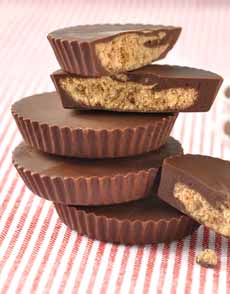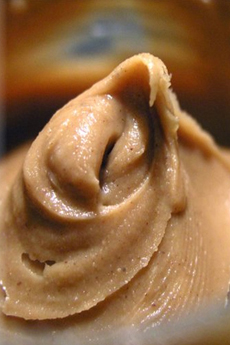

For the sophisticated palate, gourmet peanut butter cups, with superior-quality chocolate and peanut butter, are a heavenly trade up from the childhood favorite, Reese’s. The cups above, from Justin’s, are a delicious alternative.
November 2007
Last Updated January 2017
|
 |
The History Of The Peanut Butter Cup
Not Surprisingly, It Begins With The History Of Peanut Butter
CAPSULE REPORT: The peanut butter cup is a relatively recent invention: It dates to the Roaring ‘20s. Peanut butter itself is only slightly older, debuting in 1904 as—of all things—a high-protein food substitute for people who could not chewing meat.
How many peanut butter cups are sold in America today? It’s impossible to count the work of every artisan producer, but those cups would be mere rounding error on the balance sheet of the world’s largest manufacturer of peanut butter cups, Reese’s.
Harry Burnett Reese, a former dairy employee of Milton S. Hershey, was so inspired by Mr. Hershey that he left to start his own candy business. The H.B. Reese Candy Company had some success with Johnny Bars and Lizzie Bars (caramel-like molasses and coconut candy) and also had its share of adversity.
By the mid-1920s, it was manufacturing a product made with specially-processed peanut butter and chocolate from the local Hershey Chocolate Company. Introduced simply as peanut butter cups, as its popularity grew the candy became known as Reese’s Peanut Butter Cups.
Fast-forward to 1963: Reese returns to Hershey’s when The H.B. Reese Candy Company, Inc. is sold for $23.5 million to the Hershey Chocolate Company (then known as Hershey Foods Corporation).
Today, the original peanut butter cup has spawned more than two dozen variations including Big Cup, Caramel, Crunchy Cookie, Dark Chocolate, Fudge, Honey Roasted, With Nuts, and White Chocolate, as well as E.T.’s favorite, Reese’s Pieces.
The History of Peanut Butter
|
|

The original, if not in the original packaging. Photo courtesy Simple Girl At Home. |
Ever since there were peanuts, cultures have been cooking with them, whole or chopped, in savory and sweet preparations.
While George Washington Carver invented a form of peanut butter, the smooth, spreadable peanut butter as we know it was invented in 1890 by a St. Louis physician. He sought a high-protein food substitute for people with poor teeth and a resulting difficulty of chewing meat.
That first creamy PB was made by a local food producer, George A. Bayle Jr., and sold by the pound, scooped from a barrel at the corner grocery store (as were many products of the day).
Because of its nutritional appeal, peanut butter was adopted by health spas, and known to wealthy people who frequented them. Recipes for early 20th century tea sandwiches included peanut butter.
Companies began selling peanut butter as a mainstream product, targeting their promotions to the upper classes. When this market became saturated, the manufacturers began to add sugar to give peanut butter appeal to children.
That’s when PB took off to become the popular product it is today—and ironically, on a trajectory from the tea salons of the upper classes to a budget staple of the far-from-upper-class.
Some notable dates in peanut butterdom:
- 1904: C.H. Sumner is the first to introduce peanut butter to the masses at the Universal Exposition in St. Louis.
- 1908: Krema Products Company of Columbus, Ohio begins selling peanut butter, and remains the oldest peanut butter company still in operation today.
- 1922: Joseph L. Rosefield of California begins to sell a smooth-churned peanut butter that differs from the other, gritty, peanut butters. He soon receives the first patent for a shelf-stable peanut butter which will stay fresh for up to a year because the oil doesn’t separate out. One of the first companies to adopt this new process is Swift & Company for its E.K. Pond peanut butter. 1928: E.K. Pond peanut butter is renamed Peter Pan.
- 1932: Following a dispute with Peter Pan, Rosefield begins producing peanut butter under the Skippy label.
- 1934: Rosefield creates the first crunchy-style peanut butter by adding chopped peanuts into creamy peanut butter at the end of the manufacturing process.
|
|

Originally created to deliver protein to people who couldn’t chew meat. Photo courtesy Nutty’s Peanut Butter.
|
- 1955: Procter & Gamble acquires W.T. Young Foods of Lexington, Kentucky, makers of Big Top Peanut Butter.
- 1958: Procter & Gamble introduces Jif (and now operates the world’s largest peanut butter plant, producing 250,000 jars daily).

|






